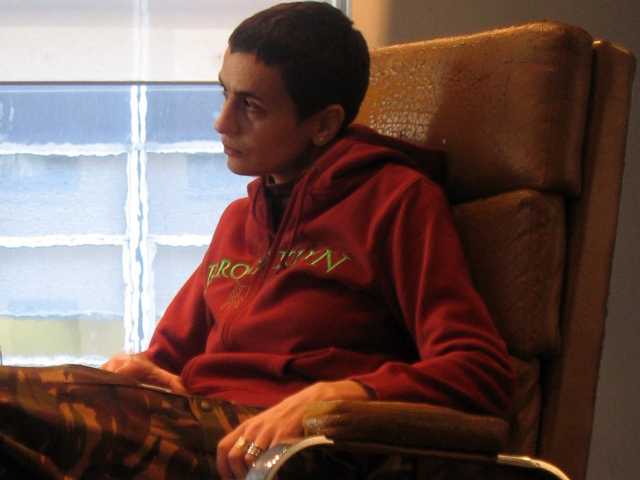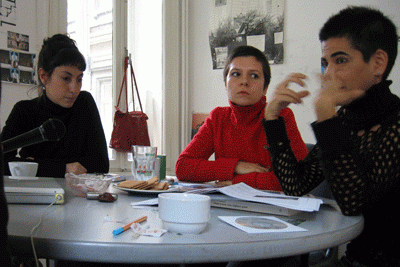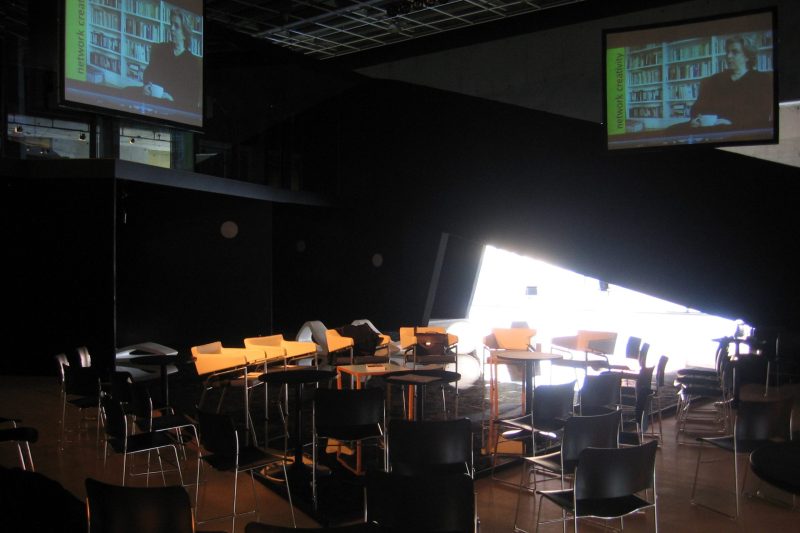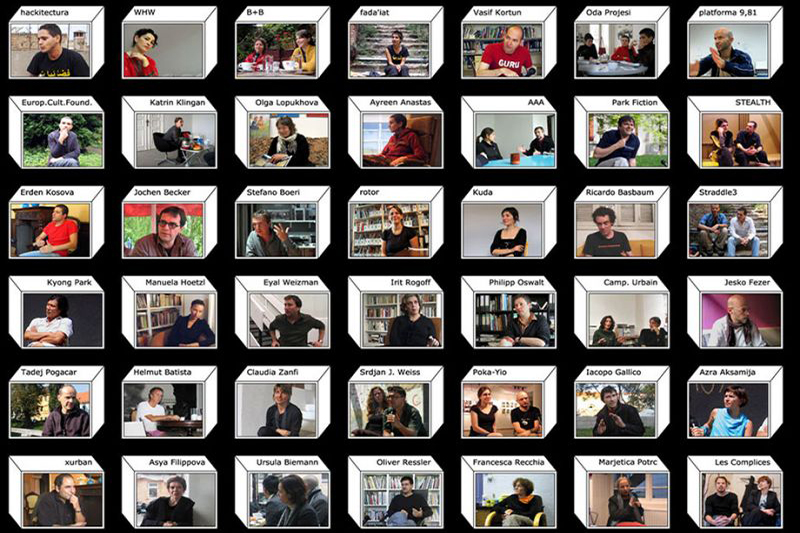- Interview
- New York
- NETWORKED CULTURES
CONVERSATION WITH AYREEN ANASTAS AND RENE GABRI
PM/HM: Your project Camp Campaign includes a cartography outlining your trip through the United States and highlighting particular camp sites, but also representing dialogues and meetings, encounters that you had during this journey. How did you bring together such a particular instrument with fundamental political issues and expressions of personal experience in an art project?
Ayreen Anastas: The project is called Camp Campaign, the exhibition takes its name from a script which we had prepared for it: Project For An Inhibition in New York or How To Arrest A Hurricane. The exhibition is one component, our preparatory research and conversations, the trip, and the map were other elements of the project. They all relate to each other, but every phase confronted its own particular set of questions.
We started by asking ourselves what was a topic which we felt was critical and needed to be addressed today. This lead us to think about what was happening in Guantánamo and made us want to connect it to everyday phenomena like what we had seen in our visits to East Baltimore or even the situation in Palestine. We formulated the following question to help give us some orientation: How is it that a camp like Guantánamo Bay can exist in our time?
Here we are not necessarily looking for a straight answer. More, we would like to open up a discussion and think about it ourselves alongside others, by introducing analogies, parallels, and retrieving histories.
Rene Gabri: The drive across the US was itself a kind of poetic operation., since it tracked a word (camp) and a set of related ideas through geographical space. It combined very different contexts, historical periods and circumstances with one another, sometimes uneasy associations were made. We also gave talks and presentations along the way, which challenged the participants not to isolate those camps in Guantánamo, but to see that it is one piece of a much larger and problematic puzzle, history, situation. Since we was a campaign, we also combined different modes of representation, different modes of address to the public.
Ayreen Anastas: The map initially was not meant to be a public document, it started instead as a practical device to help us orient ourselves, but mostly choose a route that would make most sense for our project and search. We knew we wanted to meet certain people or to visit specific places/communities. We needed to map those out to see where they were located and how we can make the most out of a line of movement through the US, that became our trip. The map gained more and more layers of information as we proceeded with the project.
We started with a line drawing of the US map that we traced ourselves. We overlapped several information layers and maps on top, such as native American lands and reservation, internment camps, relocation centres and citizen isolation camps from World War II, boot and military camps, former POW camps, prisons and detention centres. We also mapped cities and people we wanted to visit.
We created a legend that contained the symbols to indicate each of the above. And these symbols were distributed all over the map. So that the map gained density from which our route defined itself or crystallised.
For example, Baltimore is one such density on the map. We had spent a month there before starting the tour, where we met a lot of interesting people. Our question was also investigated in Baltimore as a city and in how urban planning can create a situation similar to a camp, especially for the African American community, which has become an unwanted ‘population’ or demographic for developing and selling properties in the once neglected parts of the city.
We took the same question with us to Palestine when we went there early last year in March. All Palestine can be seen as a camp, yet we were looking at more specific situations there and trying to record and connect them.
One investigation for example concerns urban planning in the city of Ramlah and Lod and how it is used there to exclude and suffocate any possibility of growth for the Palestinian community within Israel in the so-called mixed cities (Non-Jewish Palestinians and Jewish citizens of Israel). Lod and Ramlah are such mixed cities, and the authorities and planners are always concerned to keep the ratio of 80% Jews to 20% Palestinians there. Those Palestinians do not have the same status as the Palestinians in the occupied territories, they are supposedly citizens of the state of Israel.
Another investigation concerns the unrecognised villages of the Bedouins in AL-Naqab in the south of Israel. There we met with a geographer and a community organiser who explained to us their situation. The villages are declared ‘illegal’ because they are undesired people living on desirable land. The state of Israel would like to concentrate those Bedouins in housing projects and concrete buildings which does not match their way of life.
Rene Gabri: So our ‘poetic operation’ also had very strong political implications. Of course, each of these phenomena have their own histories and specific questions attached, but we felt it was also necessary to begin to see what they had in common. If we continue to isolate such phenomena, we risk isolating our resistance to them.
PM/HM: What are the undercurrents that connect such different geographies and how can one open up one’s personal practice to engage with all these different issues arising from trans-local ruptures?
Ayreen Anastas: What we have here are some kind of glasses that we see the world with. They are analytical glasses, filters of these realities. One basic question for example that we see relevant, is how the economic dynamics created by neo-liberal policies combine with the often racist policies which underlie many of the situations we were exploring.
In other words, what motivates us is what matters to us, and the question that remains is how can we do something about it, no matter where we find ourselves. The situation may differ, yet having this kind of analysis or glasses is helpful. Otherwise one is not grounded in a way, and may lose orientation.
We are able to build lines of connections to many issues, people and classes regardless of the geographic location. In addition, there is also personal experience that adds an affinity to one case or another.
Rene Gabri: I would just add that there have been thinkers along the way, whose work has been absolutely critical to us (Clastres, Celan, Benjamin, Kafka, Butler, Agamben, Holmes, Harvey, Rancière). If you look for instance at the analysis offered by Giorgio Agamben in his books Homo Sacer or State of Exception, they are essential for offering these filters Ayreen is mentioning. But at the same time, for Agamben’s own critique to have some value or validity, it needs to be interrogated further, it needs to be used (not just demonstrated), explored in specific contexts, confronted with other critiques, other lenses, other histories. I think another question which informs a lot of our collaborative work is how to connect critiques, ideas or thoughts to our own practice, to our work, to our politics, our everyday life. Because sometimes, philosophical or analytical insights are abused, instead of helping us understand things, they are used as a crutch or even worse, a barrier.
PM/HM: What importance does a network which is held up by a mutual horizon, like the 16 Beaver group in New York, have in such a context? How does a sense of communality develop along the need for continuous change and transformation in response to different situations?
Ayreen Anastas: Informal and light. We meet regularly and it is part of our everyday life. We do not need funders nor board members to approve our programmes. And if something comes up that is of interest to us, or needs to be addressed, we organise something in relation.
Rene Gabri: Our intellectual exchange is always being filtered through rigid institutions and very directed situations, from universities and museums to billion dollar websites. We, in turn, are each asked to be small corporations, competing with one another, nominated, ranked, specialised, gaining in value and junk like this. This is deadly for thought and for life. So yes, networks like 16 Beaver (and there are many) help establish grounds for a general intellect, for sharing questions and thought. Many of our largest problems are common, they are economic questions of sustenance, they are questions of health, of our capacity to attain a voice, to be involved in a conversation about how to organise society, our capacity to think and share ideas, to be creative, to contribute to a general intellect, to consider the ecological implications of our actions, to seek social justice, to critique or resist domination if necessary, … Of course, there are different infrastructures which support this type of collective thought, exchange, and activity; but some are unfortunately terminal, too hierarchical, too closely associated to, funded by, or even serve the very institutions which are part of the problem. Modest initiatives, like 16 Beaver can keep things cheap, plausible, and self-sustaining. Our trip across the US allowed us to also connect to other initiatives or individuals involved in similar efforts. If we are building these networks parallel to the dominant ones, we also need to give time to them, make use of them. We do not need to abandon the universities or museums, we just cannot let them dictate what counts or what matters.
PM/HM: Informality supports a mode of survival on the one hand, and provides the ground on which networked practices grow and thrive on the other hand. Deregulation as the main characteristic of new forms of spatial distribution is thus a very ambivalent phenomenon. How can one inhabit such a situation?
Rene Gabri: For me, informality and de-regulation are highly ambiguous terms today. Fundamentally, we are being asked to make a false choice. The so-called-free-market has been associated with horizontality, de-regulation and informality. On the other hand, the statist models of Leftist politics have been critiqued as being rigid, centralised, overly regulated etc… But as we experience Capitalism, we know it to be anything but a free market, anything but de-regulated, anything but horizontal. It is highly regulated with its regimes of property, borders, copyrights, trademarks, and patents. The same neo-liberal agenda which seems to underwrite ’globalisation’ is also responsible for the most massive dispossession of the commons (i.e., privatisation) and destruction of informal or cooperative spaces/economies. So, the language we employ in these contexts is riddled with ideological veils and misnomers.
I would prefer not to see a space like 16 Beaver in conjunction with ’de-regulation’. I would rather see it in a long line of attempts historically at various levels of society to organise infrastructures which try to re-distribute power back to people – initiatives which resist highly centralised and controlled spaces of exchange and discourse. The rigid and hierarchical spaces have historically emerged from both right and left, they have different origins, names attached, but the effect has been the same, to concentrate power and wealth.
What is the most important thing to salvage from a Leftist politics is not that statist legacy, but its insistence on maintaining a commons, its insistence to re-consider and redefine the political community, its ability to win basic rights for each and every individual (health care, education, a place to live, …) and its ability to connect local and more global concerns.
Ayreen Anastas: Well, a good way for me to address this question is by considering the Palestinian context. Authority counts on formality or a semblance of it. For me, as a Palestinian, authority has always been bad authority, as a kid, as a young person and it took me a long, long time to understand what people were talking about in Germany or here in the United States. I still may not understand it frankly, the nation states and their governments legitimised by this thing called democracy.
A Palestinian, still today, has to live with tricks in order to survive, the tricks of the weak, because geographically, if you need to move, you need to think of a trick. To overcome the ‘formalities’ of the occupier and the state machine. These ‘formalities’ are more of bureaucracies that hinder life and movement of the Palestinians. So you need a permit to move from your bathroom to your living room. Poor people have a harder time circumventing these formalities.
To go back to 16 Beaver, one important point about informality is to know that we do have agency, and that we can overcome the social checkpoints and barriers whether real or imagined. We can connect to others, talk and organise with them, collectively becoming a force that is harder to break.

Ayreen Anastas
writes in fragments and makes films and videos. Pasolini Pa* Palestine (2005), m* of Bethlehem (2003), the Library of Useful Knowledge (2002) have been shown internationally in festivals, museums and cinemas but not yet broadcast on television. The new shorter Oxford English Dictionary was published in Rethinking Marxism, Volume 16, Number 3, July 2004. She has no affection for the proclamation of victory. Troubled by any image of herself, suffers when she is named.
Rene Gabri
is interested in the complex mechanisms that constitute the world. He works alone as well as collaboratively within the folds of cultural practice and politics. Through his involvement with 16 Beaver (16beavergroup.org), Rene has helped organise public readings, discussions and social activities. Along with Erin McGonigle and Heimo Lattner, he also works under the name e-Xplo (e-Xplo.org), which has resulted in a variety of public art projects exploring social, economic and political forces.


